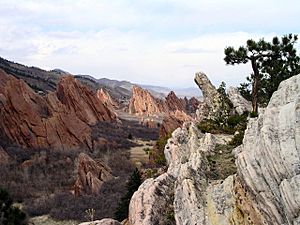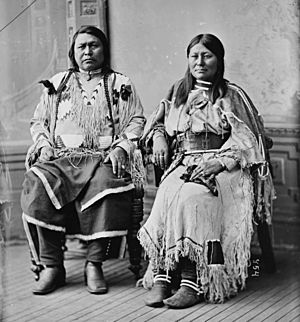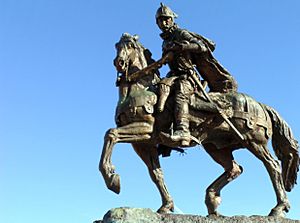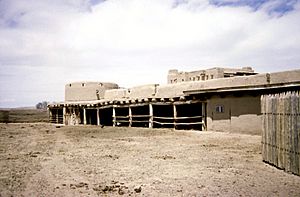History of Colorado facts for kids
The human history of Colorado goes back over 14,000 years! Long ago, the land that is now Colorado was home to Native American people. One of the oldest known places where people lived is the Lindenmeier Site in Larimer County, Colorado. Here, scientists found tools and items from the Folsom culture, dating back to about 8710 BC.
Later, explorers, fur trappers, hunters, and gold miners came to Colorado. They found many American Indian nations living here. As more European settlers moved west, Colorado's recorded history began. This involved agreements and wars with Mexico and Native American nations to gain land. In the early days of the Colorado gold rush, the area was part of the Kansas Territory and the Jefferson Territory. On August 1, 1876, Colorado officially became a state. Its borders remained the same as when it was a territory.
Contents
Native American People of Colorado
Many different Native American groups lived in Colorado throughout history. Here are some of them:
- Ancient Pueblo People — These groups lived in the valleys and flat-topped mountains (mesas) of the Colorado Plateau.
- Apache Nation — They spoke an Athabaskan language. In the 1700s, they lived on the Great Plains. Later, they moved south to Texas, New Mexico, and Arizona. This left space on the plains for the Arapaho and Cheyenne.
- Arapaho Nation — This Algonquian-speaking group moved west to the base of the Rocky Mountains in the late 1800s. They settled on the flat lands near the mountains and the eastern plains. After the Colorado War in 1865, they were moved out of Colorado.
- Cheyenne Nation — The Cheyenne also spoke Algonquian and were closely related to the Arapaho. They also moved west in the 1700s. They often lived in groups mixed with the Arapaho. Like the Arapaho, they were moved out of Colorado in the 1860s.
- Comanche Nation — This Numic-speaking group lived on the high plains of southeastern Colorado. They were related to the Shoshone. They got horses from the Spanish and rode across the southern Great Plains. The Comanche were later moved to Indian Territory.
- Shoshone Nation — Another Numic-speaking group. They lived in mountain valleys along the northern edge of the state. This included areas like North Park and Browns Park until the late 1800s.
- Ute Nation — The Ute are a Numic-speaking group. They have lived in the Southern and Western Rocky Mountains for many centuries. Their famous leaders were Chief Ouray and his wife, Chipeta. They often fought with the Arapaho and Cheyenne. They also resisted settlers moving into the mountains. Until the 1880s, the Ute controlled most of Colorado west of the continental divide. This changed after the silver boom of 1879. After conflicts like the Meeker Massacre in the 1880s, most Ute people were moved to Utah. Only two small reservations remain in southwestern Colorado.
Early European Settlement
The first Europeans to visit the Colorado region were Spanish explorers. Juan de Oñate founded the Spanish province of Santa Fe de Nuevo México in 1598. In 1706, Juan de Ulibarri claimed the territory of Colorado for Spain. In 1787, Juan Bautista de Anza tried to start a settlement called San Carlos near what is now Pueblo, Colorado. But it did not last. This was the only time Spain tried to settle north of the Arkansas River.
Colorado became part of Spain's province of New Mexico. The Spanish traded with Native Americans, especially the Comanche. This trade was known as the Comercio Comanchero.
In 1803, the United States bought a large area of land from France called the Louisiana Purchase. This included the eastern side of the Rocky Mountains. However, Spain also claimed this land. Zebulon Pike led a U.S. Army expedition into this disputed area in 1806. Spanish soldiers arrested Pike and his men in the San Luis Valley. They were taken to Chihuahua, Mexico, and then sent out of the country.
Mexico declared its independence from Spain in 1810. In 1819, the United States gave up its claim to the land south and west of the Arkansas River to Spain. This was part of the Adams–Onís Treaty. Mexico finally won its independence in 1821 and took over Spain's land claims. Mexican traders traveled north, but settlers mostly stayed south of the 37th parallel. This was until the U.S. signed a peace treaty with the Ute Nation in 1850.
From 1832 to 1856, traders and settlers built trading posts and small towns. These were along the Arkansas River and the South Platte River near the Front Range. Famous posts included Bent's Fort and Fort Pueblo on the Arkansas River. Fort Saint Vrain was on the South Platte. The main item traded by Native Americans was buffalo robes.
In 1846, the United States went to war with Mexico. Mexico lost and had to give up its northern lands in the Treaty of Guadalupe Hidalgo in 1848. This opened the Southern Rocky Mountains to American settlers. The new land included the lower part of what is now Colorado. This land was divided into the New Mexico Territory and the Utah Territory in 1850. The Kansas Territory and Nebraska Territory were organized in 1854. Most settlers avoided the rugged Rocky Mountains. They headed for Oregon, Deseret, or California, usually following rivers through what is now Wyoming.
On April 9, 1851, Hispanic settlers from Taos, New Mexico, founded the village of San Luis, Colorado. This was in the New Mexico Territory. It became Colorado's first permanent European settlement.
Pike's Peak Gold Rush
On June 22, 1850, a group of people heading to California found gold. Lewis Ralston found almost $5 worth of gold in his pan in a stream flowing into Clear Creek. This stream was later named Ralston's Creek.
Ralston went to California, but he came back to Ralston's Creek eight years later with the Green Russell party. In 1858, members of this group founded Auraria, which later became part of Denver City. This discovery started the gold rush to the Rockies! The place where Clear Creek and Ralston Creek meet, where Colorado's first gold was found, is now in Arvada, Colorado.
In 1858, several groups of gold seekers found small amounts of gold in streams in the South Platte River Valley. This was at the base of the Rocky Mountains in what was then western Kansas Territory. The first gold nuggets did not impress them much. But rumors of gold in the Rocky Mountains continued. In the summer of 1857, Spanish-speaking gold seekers from New Mexico found gold along the South Platte River. This was about 5 miles (8 km) above Cherry Creek, in what is now Denver.
The next year, William Greeneberry "Green" Russell led a group of Cherokee gold seekers from Georgia. They searched for gold along the South Platte River. In early July 1857, Green Russell and Sam Bates found a small amount of gold near Little Dry Creek. This was the first important gold discovery in the Rocky Mountain region.
News of this discovery spread quickly. It started the Pike's Peak Gold Rush. About 100,000 gold seekers rushed to the area over the next three years. The easy-to-find gold in the rivers and streams quickly ran out. But miners soon found much more valuable gold, silver, and other minerals deep inside the mountains. This gold rush brought many people to Colorado and caused a huge population increase.
Territory of Jefferson
The Provisional Government of the Territory of Jefferson was formed on October 24, 1859. However, the U.S. government did not officially approve this new territory. This provisional government managed the region even without official status. It continued until the U.S. Colorado Territory was created in 1861.
Colorado Territory
The Colorado Territory was an organized territory of the United States from 1861 to 1876. Its borders were the same as today's State of Colorado. The territory ended when Colorado became a state on August 1, 1876. The territory was created after the 1859 Pike's Peak Gold Rush. This gold rush brought the first large group of white settlers to the region.
The law that created the territory was passed by Congress and signed by President James Buchanan on February 28, 1861. This happened during the time when Southern states were leaving the Union, leading to the American Civil War. Creating the territory helped the Union control a mineral-rich area in the Rocky Mountains.
Becoming a state seemed likely. During the 1864 presidential election, the Republican-controlled Congress wanted two more Republican senators and three more electoral votes for President Lincoln. Territorial Governor John Evans convinced Congress to pass a law allowing statehood. However, most of the 6,192 Coloradoans who voted (out of about 35,000 people) rejected the first attempt at a state constitution. A second attempt at statehood also failed. Later, in late 1865, President Andrew Johnson vetoed statehood for the territory. Statehood for Colorado was a repeated topic during the Ulysses Grant presidency. Grant supported statehood, but Congress was less willing during the Reconstruction period.
Colorado War
The Colorado War (1863–1865) was a conflict between the United States and an alliance of Kiowa, Comanche, Arapaho, and Cheyenne Native American nations. The last two groups were especially close allies. The war mainly took place on the Eastern Plains of the Colorado Territory. It led to these four Native American groups being moved from present-day Colorado to present-day Oklahoma.
A very sad event happened in November 1864, known as the Sand Creek massacre. This battle was first praised by the U.S. press as a great victory. But later, people learned it was a brutal attack. Hearings in the United States Congress looked into the actions of the U.S. Army commander, John Chivington. This event was a turning point in how white people viewed the American Indian Wars at the end of the American Civil War. In 1868, the U.S. Army, led by George Armstrong Custer, fought again against the Arapaho and Cheyenne at the Battle of Washita River.
Colorado Becomes a State
The United States Congress passed a law on March 3, 1875. This law set the rules for the Colorado Territory to become a state. On August 1, 1876, which was 28 days after the 100th birthday of the United States, U.S. President Ulysses S. Grant signed a paper. This made Colorado the 38th state to join the Union. Because it joined during the country's centennial year, Colorado earned the nickname "Centennial State". The new state's borders were the same as the Colorado Territory's.
Women in Colorado won the right to vote in 1893. Colorado was the first state where women gained this right through a public vote. (Wyoming had approved women's right to vote in 1869 through its territorial legislature.)
Governor Davis H. Waite worked hard for the change to the state's constitution that gave women the right to vote. Governor Waite is also known for being one of the few elected officials to call out the state militia. He did this to protect miners from a force created by mine owners. Governor Waite was a member of the Populist Party.
Mining in Colorado
People who took part in the Pike's Peak Gold Rush from 1858 to 1861 were called Fifty-Niners. Many of these new arrivals settled in the Denver area. Gold was also found in large amounts in the Central City area. In 1879, silver was discovered in Leadville. This led to the Colorado Silver Boom.
Many early mining efforts were done together by groups of people. But as the easy-to-reach gold near the surface ran out, miners started digging deeper. This "hard rock mining" needed more money and bigger operations. The idea of mineral rights sometimes caused problems between mine owners and the miners who worked for them.
As mines went deeper, they became more dangerous and the work harder. This led to conflicts. In 1880, Colorado Governor Frederick Walker Pitkin, a Republican, declared martial law. This was to stop a violent mining strike in Leadville. In the 1890s, many Colorado miners started forming unions to protect themselves. Mine operators often formed their own groups in response. This set the stage for more conflicts. Important labor disputes between hard rock miners and mine operators included the Cripple Creek strike of 1894 and the Colorado Labor Wars of 1903-04.
Coal mining in Colorado began soon after the first settlers arrived. Finding coal did not cause big "boom" periods like precious metals did. But the early coal mining industry also led to violent fights between miners and mine owners. The usual issues were wages, hours, and working conditions. But miners also cared about fairness and how much control companies had over their lives.
Early coal mining in Colorado was very dangerous. The state had one of the highest death rates in the country. From 1884 to 1914, over 1700 men died in Colorado's coal mines. Coal miners also did not like having to pay for safety work, like putting up wooden supports in the mines. Sometimes, they were paid in special money called "scrip" that only worked at the company store. The company set the prices there.
A strike in 1913 led to the Ludlow Massacre in 1914. Another coal strike in 1927 is known for Colorado's first Columbine massacre. In 1933, a new federal law allowed all Colorado coal miners to join unions without fear of being fired.
Like all industries that take resources from the earth, mining is a "boom or bust" business. Over the years, many small towns were built, then abandoned when the minerals ran out, the market crashed, or another resource became available. There were once over a hundred coal mines north of Denver and east of Boulder. These mines started closing when natural gas lines arrived. Coal and precious metals are still mined in Colorado today. But the mining industries have changed a lot in recent decades.
Today, many small mining towns are scattered throughout Colorado. Examples include Leadville, Georgetown, Cripple Creek, Victor, and Central City. Many of the mines no longer operate. But you can still see the remains of the operations, like mine shafts, old buildings, and piles of rock. Many former mining towns turned to gambling to attract visitors. Blackhawk and Cripple Creek are good examples. The 1800s ended with some difficult law-and-order situations in places like Creede, Colorado. Here, gunmen like Robert Ford (who killed Jesse James) and con men like Soapy Smith were in charge.
Twentieth Century in Colorado
The 1930s marked the start of the ski industry in Colorado. Ski resorts were built in areas like Estes Park, Gunnison, and on Loveland Pass. During World War II, the 10th Mountain Division set up Camp Hale to train special ski troops.
In the 1940s, Colorado's Republican governor, Ralph Carr, spoke out against racism. He also opposed the U.S. government's decision to put Japanese-Americans in special camps during World War II.
The late 1960s saw violence in Denver. This included race riots and college buildings being burned by radical groups.
In 1972, Colorado became the only state to refuse to host the Olympic Games after being chosen. Representative Lamm led a successful effort to reject a bond issue for the event's costs. Because of this, the International Olympic Committee moved the 1976 Winter Olympics to Innsbruck, Austria. No city or place had ever rejected hosting the Olympics before, and none has since.
Images for kids
-
Fairplay, Colorado Front Street in 1888.
See also
 In Spanish: Historia de Colorado para niños
In Spanish: Historia de Colorado para niños












